Bucket Bums
A charter cruise goes upscale when this crew crashes the St. Barths Bucket superyacht regatta
The St. Barths Bucket Regatta is a true “bucket list” item for many sailors—a glitzy gathering of superyachts on the trendy Caribbean island of Saint Barthélemy. But with our quivers just shy of a 100-foot luxury sailboat suitable for entry, we decided to do the next best thing: charter a cruising catamaran and crash the Bucket.
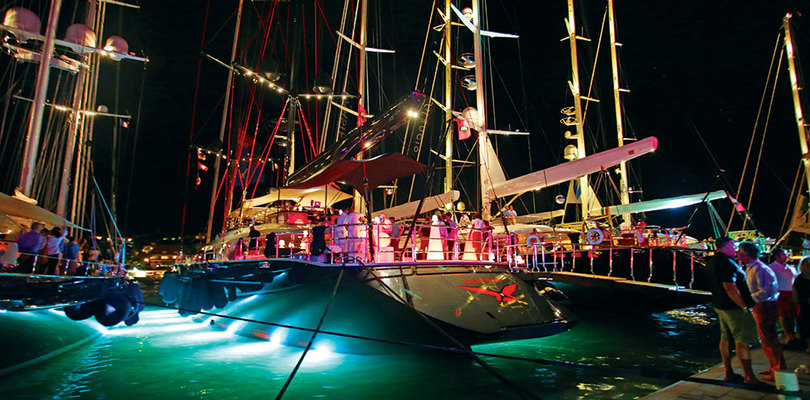
The Bucket was founded in 1986 in Nantucket for summertime racing among well-to-do friends, and in 1995 the St. Barths regatta was added in the flip season. Just a handful of superyachts turned out in those early years for Corinthian racing and some even dropped a fishing line. But over time it has become one of the most elite yachting events in the world, and the dinged-up bucket trophy has become one of the most coveted. For one week in late winter, three dozen superyachts converge on this eight-square-mile island for an extravaganza of spit and polish. It’s about as ritzy as it gets. St. Barths is stylish. It is quaint. It is pricey.
Our crew included Harken Yacht Equipment co-founder Peter Harken and his wife Edit, Iris Asbury-Strang and photographer Bob Grieser. Iris and Edit provisioned generously at Aux Pains d’Epices, a French market less than a quarter mile from Sunsail’s charter base at Oyster Pond in Saint Martin. It’s an easy walk past several tiny and excellent bistros (with Wi-Fi) to the shop where you can stock up on produce, wine, cheese and other delicacies from the motherland that the charming owner will deliver to the dock. Meanwhile I enjoyed an incredibly thorough briefing tailored to our endeavor and Sunsail 444 four-cabin catamaran.
We maneuvered the tricky exit from Oyster Pond, made more hair-raising by the missing channel markers and intimidating waves on either side. Our first stop was Île Pinel, a tiny islet on the north side of Orient Bay just four miles away. It is a popular spot with tourists who ferry out for lobster and cocktails, but it clears out in the evening when they pack up and ship back to the mainland. We picked up a mooring, having paid the $15 marine reserve fee in advance at Sunsail, and swam ashore for a cocktail and late lunch at one of the beachside palapas. The island was dense with trees and busy with colorful birds that flitted about. White sandy beaches bled into turquoise waters, and the temperature was ideal. Back onboard, a fabulous breeze kept the boat cool and bug-free. It was quiet, secure, calm and we spent a blissful first night aboard.
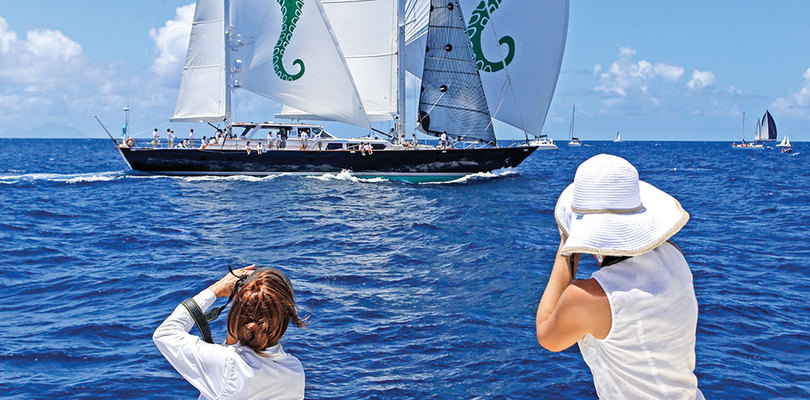
With 15 to 20 knots of breeze and sizeable waves, it was an exhilarating reach. Peter took the helm and I sat in the forward cockpit because it was too wet on the trampoline, with sea spray exploding through the mesh. The jib cut smartly across the cobalt sky. It was an invigorating and swift passage as we bucked across the 11-mile passage at 7 knots. The catamaran handled the conditions easily and comfortably, and soon we saw the unmistakably lofty Bucket yachts massing outside Gustavia Harbour.
We stopped short of St Barths at Île Fourchue, a small, scruffy island with a perfectly curved west-facing bay. Also part of the reserve system, it has a field of mooring balls scantily occupied, and we took one near the middle. We spent the rest of the day in the idyllic cove, swimming in the crystal clear water, walking the beach and kayaking along the rugged edges, spying thick purple sea stars and sea urchins in the crevices of the jewel-toned rocks.
As we explored, a grand, navy blue superyacht pulled in and anchored. We immediately investigated Parsifal III, a 178-foot Perini Navi that, although it was 10 years old, was so pristine it could be 10 days old. Countless guests and crew emerged like a circus car, where an endless stream of clowns pour out, deployed some toys and splashed around, then just as quickly disappear below deck. For a meal? Siesta? We will never know what went on behind the mirrorlike hull dappled with reflected sunlight. Soon they weighed anchor and departed.
As we dined, a rain squall rattled through, but it lifted in time for a glimpse of a golden sunset behind La Petite Falette rock. Following breakfast the next morning we set off for the quick four-mile jaunt to Gustavia, the capital and main harbor on St. Barths. Stately yachts were parading out, their proud crews impeccably dressed in matching gear, eliciting oohs and aahs from spectators. We wove through the anchorage thick with rubberneckers and anchored, which was no small feat with hundreds of boats already there. The holding was good, and the steady wind that whistled down the fairway deterred any wayward swinging.
As is required when arriving in Gustavia we had to check in even though we had arrived from French Saint Martin, so we swiftly dinghied into the charming wharf. Pristine buildings with red tile roofs lined the narrow inlet. A lighthouse at Fort Gustav on the northern corner offers great panoramic views: At the southern thumb is Fort Oscar and slightly farther south is Fort Karl. These garrisons tell of the volatile past of St. Barths that has passed hands many times since being discovered by Christopher Columbus in 1493 and named after his brother Bartolomeo.
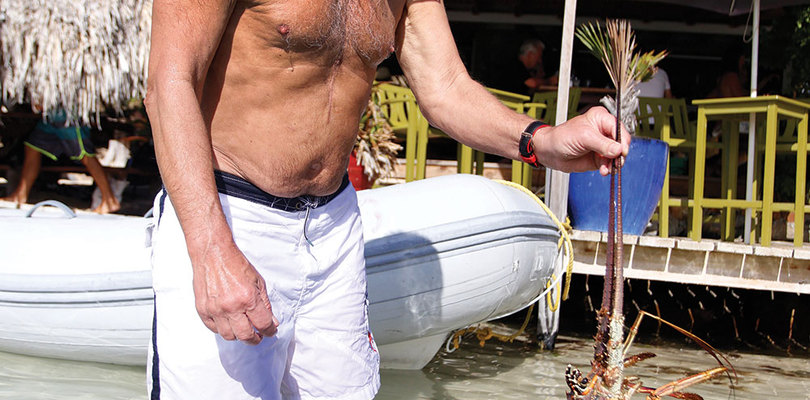
And in fact they were. It took nearly an hour for divers and tenders to unleash the bow anchors and free the yachts. We breezed through check-in, typing on the computer with the funny keyboard and paying about $100 for three nights in the anchorage.
We caroused in the dinghy, watching the start, then returned to our boat as the yachts begin their counterclockwise, 20-mile romp around the island. Commentator Michael Ledersole, the traditional “Voice of the Bucket,” gave a rapid-fire play by play over the VHF. A yacht broker with Northrup and Johnson, and longtime Bucket participant, his commentary is informative and witty. These daily broadcasts added immensely to our comprehension and the atmosphere and made us feel like part of the event.
Typically a superyacht is a luxury yacht 100 feet or longer, although this year’s 38 entrants ranged from the 88-foot Lush and Wavelength to the 216-foot Hetairos. Each boat might cost in the tens of millions of dollars to build, and another $5 million a year to run. Most have state-of-the-art equipment and hardware on deck, and fine art and luxuries below. Their masts reach upward of 200 feet, so high they carry red aircraft warning lights typically seen on skyscrapers and radio towers.
That evening we strolled the race village abreast the port office where the fleet open house was being held. Masthead and party lights twinkled above, colored flood lights illuminated the sea below. The eye-popping lineup of yachts was even more impressive up close and the entire quay gleamed and pulsed with music and the hustle-bustle of sailors and guests.
Fortunately, we ran into Dawn Riley who invited us aboard Silencio, a spectacular 165-foot Perini Navi. We were ushered aboard up the steps to the boarding ramp, strutting along the catwalk, suddenly, we were in the thick of it. The top tiers buzzed with people: a who’s who of celebrities from the yachting world and beyond. Servers whizzed by with hors d’oeuvres and cocktails, and just as swiftly swept up the remains. It was miraculous how rapidly the crew transformed the yacht from racing machine to a on-the-water discotheque, where we danced for hours. Eventually we tore ourselves away from the party and retired to our cozy boat.
Saturday we popped into town for croissants and cappuccino. The island’s population of 7,000 surges during the Bucket, and Gustavia was a madhouse. Tiny cars zoomed through the narrow cobbled streets and smartly dressed ladies nonchalantly ignored the fray. There were bistros and elegant restaurants, jewelry stores and designer boutiques, and one haughty shop that seemed to sell exclusively long-sleeve white button-down shirts. We discovered a grocery store with a remarkable selection of fresh produce and a wine shop across the street to replenish our supplies.
Bobby secured a spot on a press photo boat and the rest of us returned to the catamaran, eager to get a closer look at the racing action. Once underway we fell in alongside some of the superyachts, sparkling and regal, with their strapping crews in matching uniforms.
With a brisk 18-knot breeze, the seas were too lumpy for us to linger long near the marks. Instead we tucked into Baie du Columbier, a small cove in the northern end of the island that looked squarely at the “Not So Wiggly” random leg course they were racing that day. We lazed in the cockpit beneath the bimini, watching the yachts slide by. Sea turtles thrive in the sea grass beds of this calm anchorage, and we saw plenty from the deck. Columbier is accessible only by boat or footpath, making the beach delightfully empty, except for a few topless beauties sunning beneath a brilliant sky.
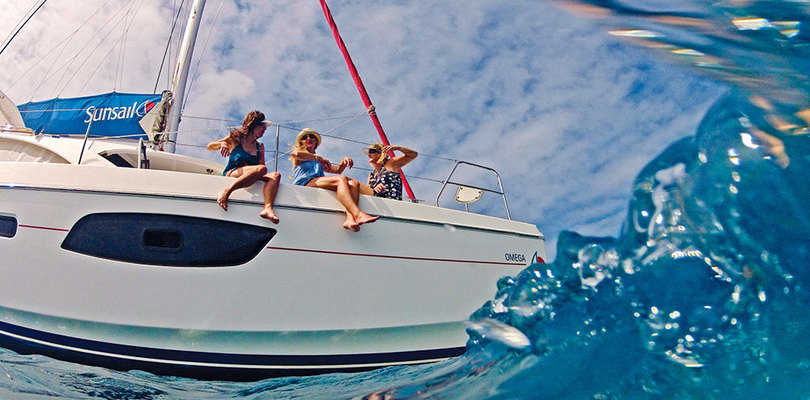
Later, friends invited us to happy hour at a villa overlooking Gustavia. From this perch we savored the bird’s-eye view of the harbor dotted with the red masthead lights and a sea of white lights beyond. Then we caught wind of a rumor: Jimmy Buffet might be making a surprise appearance at the Bucket Bash party. We sped down the hill and sure enough, his unmistakable tenor met us as we pressed our way to the stage. The popular musician and his so-familiar songs and lyrics had everyone singing and dancing. It put the super in superyachts—a night to remember always.
The wind was brisk Sunday when we went out to watch the starts. The Bucket is a pursuit race, each yacht is given a start time according to their handicap, relative to the distance and conditions of the day’s course. So the smallest yacht, Wavelength, started at 11 a.m., while the Baltic Hetarios, the fleet’s largest entrant, began nearly two hours later, with the balance of the fleet in between.
“By applying the handicap to the start time, the first boat across the finish line has won,” Nethersole said. The handicaps are formulated based on the International Superyacht Rule—a tenet credited to the Bucket and Peter Craig’s Premiere Racing, which has been running the regatta the last several years. “He’s terribly organized, and comes with his own team, who all know what they’re doing.”
Under Craig’s tutelage the event has become more polished, and the rules they’ve established have become the standard for superyacht racing worldwide. But the tone of the regatta has altered somewhat too, he said. It used to be rife with shenanigans years ago.
“Avalon would pack their spinnaker full of feathers, so when it was hoisted, there were feathers everywhere,” Nethersole said. “Another crew arrived one morning to their yacht wrapped completely in police caution tape.”
Even the famous J-class yacht Ranger was not immune. Pranksters placed a toilet on her foredeck one night, replete with a blow-up doll positioned on the loo.
We anchored and swam at nearby Shell Beach to await the finish, as the racers wrapped around the island, and started appearing round Grande Pointe. Bobby had us position our boat near the finish as they stormed the line, an intimidating task, as the mighty stallions stampeded toward us. I was glad, once again, for the maneuverability of the twin engine catamaran, as the fleet rushed past with their massive spinnakers billowing. The finishes were brilliantly close, just seconds apart in some cases, a testament to the rule, and to the skill of the crew and afterguard. Even so, “mildly terrifying,” was how pro sailor Tony Rey called the tight racing, while America’s Cup veteran Harold Cudmore said “It’s different from when you race a little boat and you tend to push it and there can be crashes. You simply can’t crash a superyacht.”
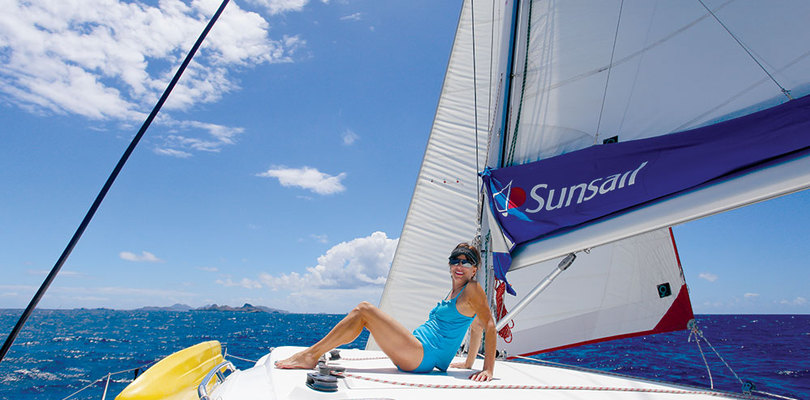

Comments